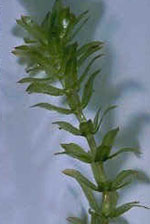Threats to Birds - Hydrilla (Hydrilla verticillata)
Overview
Hydrilla was introduced into Florida waters in the early 1950s where it was being cultured for the aquarium industry. This noxious weed is now choking springs, lakes, marshes and rivers as far away as California, Washington and Maine. Hydrilla forms green carpets thick enough for ducks to walk on. It infests nearly one half of Florida’s public waters. Hydrilla can grow 1 inch/day, and can eliminate open-water feeding areas for waterfowl and spawning sites for fish. Once established, it is nearly impossible to eradicate. Recent studies now implicate hydrilla and an associated cyanobacteria as the cause of death for at least 100 Bald Eagles and thousands of American Coot at 11 sites from Texas to North Carolina. The bacteria covers up to 95% of the surface area of hydrilla leaves in reservoirs where bird deaths have occurred from the disease.
Description
A submersed freshwater herbaceous perennial which can form dense stands (25 feet) from the bottom to the top of the water, sprawling across the surface. Produces mainly by regrowth of stem fragments; also reproduces by growth of axillary buds and subterranean tubers. Stems are long and slender, branching across the water surface; leaves are small, pointed and arranged in whorls of 4 - 8 along the stem; leaf margins are distinctly saw-toothed. Male flowers are tiny and greenish; female flowers are tiny and white.
Birds Affected
Waterfowl, Bald Eagle, American Coot
Control
Mechanical harvesting and herbicide spraying are the most common control methods. Bio-control using fish and insects is also Hydrilla continues to be sold through aquarium supply dealers and over the Internet, even though it is on the U.S. Federal Noxious Weed List. Hydrilla spreads to new waters mainly as fragments on boats and trailers. |
